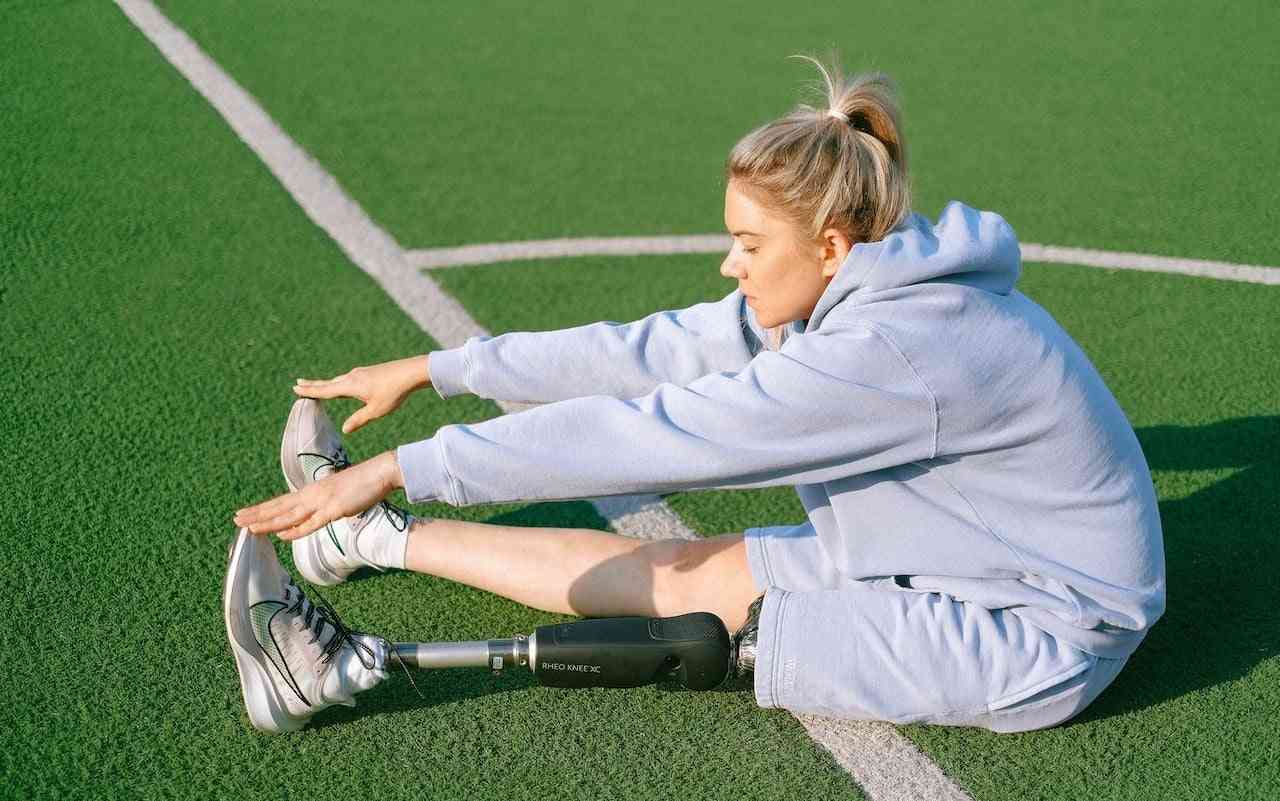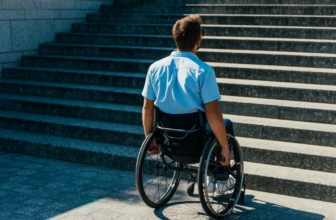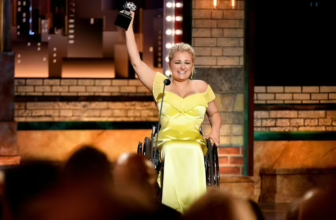It’s estimated that about 185,000 amputations are done in the United States each year, and about one in 190 Americans are currently living with the loss of a limb. The main causes of limb loss are diabetes and trauma. These exercises for amputees can help those with lower limb loss regain strength and mobility while improving their self-esteem and overall well-being.
Experiencing an Amputation Can Affect You Mentally
People whose limb has been amputated can be affected psychologically. In fact, a study published in the Journal Frontiers in Psychology in 2021 found that people whose limb has been amputated experience a range of mental health consequences, including depression, anxiety, and loss of self-esteem.
Additionally, life as an amputee can affect one physically.
How Lower Limb Amputation Affects Mobility
Lower limb amputation can cause reduced mobility. Reduced mobility can have negative implications for the rest of your leg.
A small study carried out at the University of Birmingham and Imperial College London found that muscles just above the knee can waste away because they try to protect the soft tissue around the amputation site. The study found that exercising hip muscles can compensate for weaknesses in the knee muscles and help improve functionality.
It may be hard for a person whose limb has been amputated to gather the courage to exercise for a number of mental and physical reasons.
Common Mental Challenges for Amputees Who Want to Exercise
A Distorted View of Your Body
“Amputation presents a severe blow to self-image as well as body image, and exercise can be a constant reminder that one can no longer easily take part in activities that used to come naturally,” says Robert Cuyler, Ph.D., a licensed psychologist, trauma expert, and chief clinical officer at Freespira in Houston, Texas. “When Post-Traumatic Stress Disorder (PTSD ) is part of the mix, there’s a strong tendency for the avoidance of reminders of the trauma, and exercise can be an immediate reminder of the traumatic injury that gave rise to PTSD,” he says.
“Individuals with PTSD are also often hyper-sensitive to unpleasant bodily sensations, so pain or shortness of breath during exercise can add to avoidance as a coping mechanism,” he adds. “Fear of falling or getting injured again can also play a role if physical rehabilitation has not restored confidence and tools for exercising safely.”
Fear of the Unknown
“The physical and emotional challenges associated with having an amputation can be overwhelming,” says Ketan Parmar, MD, and psychiatrist at ClinicSpots.
“Unfortunately, many people whose limbs have been amputated avoid exercise due to fear of the unknown or because they feel their disability should prevent them from engaging in activities that can help improve their fitness,” Dr. Parmar says.
“While this is understandable, it’s important to recognize that there are ways to overcome fear and still reap the benefits of regular exercise,” he adds.
Fear of Injury or Movement
“Fear of injuring their residual limb, lack of confidence, anxiety, depression, and self-consciousness about their appearance may discourage them from exercising,” says Amira Martin, LCSW-R, a licensed psychotherapist and adjunct professor at Columbia University School of Social Work.
Difficulty Adjusting to the Physical Limitations After Amputation
“You may have a difficult time adjusting to the physical limitations caused by your disability,” says Dr. Parmar. “This can lead to feelings of frustration, low self-esteem, depression, anxiety, and even fear. This fear can prevent you from taking part in exercise activities that could be beneficial to your overall well-being,” he adds.
Common Physical Challenges for Lower Limb Amputees
Decreased Balance and Stability, and Potential Pain
“People whose limb has been amputated experience limited mobility and range of motion, decreased balance and stability, and potential pain or discomfort in the residual limb or other areas of the body,” says Lalitha McSorley, a registered physical therapist at Physiotherapy Calgary who has over 40 years of experience practicing physiotherapy.
“They may also have concerns about fitting prosthetic limbs or adapting to new movements and exercise routines,” she adds.
How Exercise Can Help Limb Amputees
Among people whose limb has been amputated, exercise appears to have substantial benefits.
For example, a review published in the journal Disability Health in 2021 found that exercise can improve the fitness and functionality of people who have lost a limb.
“It helps by increasing strength, flexibility, and endurance, as well as improving balance and coordination,” says McSorley. “Exercise interventions can significantly improve functional outcomes in people whose lower limb has been amputated, such as helping them walk faster and improving their balance,” she adds.
Exercise can benefit you physically, as well as mentally. “Understand that resuming exercise can have significant benefits not only on your health and fitness, but it may also reduce the impact of PTSD,” says Dr. Cuyler.
How to Overcome Your Fears and Start Exercising After Lower Limb Amputation
If your lower limb has been amputated and you fear starting an exercise regimen, take heart. “The good news is that overcoming these fears is possible,” says Dr. Parmar. “There are strategies you can use to successfully manage your fears and begin an exercise program,” he says.
So what are some of the things you can do to conquer these fears and challenges so you can exercise as an amputee?
Seek Guidance from Medical Experts
“Seek guidance and education from your medical team about the benefits of exercise as well as education on the types of exercise that are safe, effective, sustainable, and hopefully enjoyable,” says Dr. Cuyler.
Dr. Cuyler also recommends that you seek “coaching” from trainers or coordinators who provide empathy, encouragement, and an understanding of the challenges and benefits of exercise for amputees because they will empower you to stick with a plan and cheer your successes.
Set Realistic Goals
“Be realistic about what kind of exercise you’re capable of doing, and don’t push yourself too hard,” says Dr. Parmar. “Start with small goals and gradually increase the difficulty as you get stronger and more confident,” he adds.
Begin Physical Activity Gradually
“Gradual exposure to physical activity, beginning with low-intensity exercise, can help people whose limb has been amputated build confidence and reduce fear,” says Martin. “Start with low-intensity exercises and gradually increase the intensity and duration over time. For example, you can start with simple stretching exercises, and then progress to more challenging exercises.”
“It is essential to listen to your body and not push yourself too hard too soon,” she adds.
Try Different Activities
“Not every activity is going to be right for everyone,” Dr. Parmar says. “Experiment with different types of exercises until you find one that works for you.”
Meditate
“You can use meditation to reduce stress, anxiety, and the fear of falling associated with exercising,” Martin says. “Find a quiet and comfortable place to sit or lie down and focus on your breathing.”
You may also use technology to help you. “You can use guided meditation apps or videos specifically designed for people whose limb has been amputated,” says Martin.
How should you do the meditation? “A simple meditation technique is to take deep breaths in through the nose, hold for a few seconds, and exhale through the mouth while imagining the fear leaving your body,” she adds.
Visualize Yourself Successfully Performing the Exercise You Fear
“You can use this technique to build confidence and overcome your fear of exercising,” says Martin. “Imagine yourself successfully performing the exercise you fear while feeling comfortable and confident.”
Using mental imagery to visualize the specific steps involved in the exercise and how they will feel afterward can also help you, says Martin.
“You can also visualize positive outcomes and the benefits of exercising, such as improved physical and mental health. For example, visualizing yourself walking or running with a prosthetic limb can help build confidence and reduce fear,” she adds.
Find Supportive People Who Understand What You’re Going Through
“Having supportive people in your corner will help you feel more confident about trying new things,” says Dr. Parmar. “It’s also reassuring to have people you can talk to about your experiences.”
Dr. Cuyler agrees. “Connect with others who are managing the barriers to start and maintain physical activities,” he says. “Look for a group or team that gathers regularly to exercise or engage in a sport like wheelchair basketball. That can create bonding and shared experiences that can reduce the sense of isolation or avoidance that hinders exercise and full participation in life,” he adds.
What to Consider Before Starting an Exercise Program as an Amputee
Seek Guidance from a Professional
“Working with a physical therapist or fitness trainer can help provide guidance and ensure that you are following the correct form while exercising, which is especially important for people whose limb has been amputated who may have limited mobility in certain areas,” Dr. Parmar advises.
McSorley also gives this advice. “Consult with your healthcare provider and/or physical therapist to assess your individual needs and limitations,” she says. “You should also consider factors such as the type and level of amputation, any comorbidities or medical concerns, and any prosthetic devices you use,” she adds.
How to Prepare Your Body for Exercise
“Before you start an exercise program, a person whose limb has been amputated can benefit from limbering up and stretching. It can help improve flexibility and reduce the risk of injury,” says McSorley. “A gentle range of motion exercises, such as ankle circles or shoulder rolls, can be helpful,” she adds.
Exercises for Amputees to Do Easily on Your Own at Home
There are exercises for amputees that you can do comfortably at home without the supervision of a professional. Here are some of those exercises, according to McSorley.
Clamshells
“This exercise targets the gluteus medius muscle, which is an important hip abductor. Strengthening this muscle can improve stability and balance, and help prevent falls,” says McSorley.
Procedure:
- Lie on your side with your knees bent and feet together.
- Keeping your feet together, lift your top knee as high as you can without moving your pelvis.
- Hold for 3-5 seconds, then lower your knee back down.
- Repeat for 10-15 repetitions on each side.
Here is a video you can watch to help you do this exercise.
Side-Lying Leg Lifts
“This exercise also targets the gluteus medius muscle, as well as the tensor fascia latae muscle,” says McSorley. “Strengthening these muscles can improve hip stability and help with walking and other functional movements.”
Procedure:
- Lie on your side with your bottom leg bent for support.
- Keeping your top leg straight, lift it as high as you can without moving your pelvis.
- Hold for 3-5 seconds, then lower your leg back down.
- Repeat for 10-15 repetitions on each side.
Here is a video you can watch to help you do this exercise.
Hip Bridges
“This exercise targets the glutes, including the gluteus maximus, which is another important hip abductor muscle,” says McSorley. “Strengthening this muscle can help with walking, climbing stairs, and other functional movements.”
Procedure:
- Lie on your back with your knees bent and feet flat on the ground.
- Lift your hips up towards the ceiling, squeezing your glutes and keeping your core engaged.
- Hold for 3-5 seconds, then lower your hips back down.
- Repeat for 10-15 repetitions.
Here is a video you can watch to help you do this exercise.
Lunges
“Lunges are a functional movement that targets the glutes, as well as the quadriceps and hamstrings,” says McSorley. “Strengthening these muscles can improve balance, stability, and overall lower-limb strength.”
Procedure:
- Stand with your feet hip-width apart.
- Step forward with one foot, keeping your knee directly over your ankle.
- Lower your back knee down towards the ground, keeping your front knee at a 90-degree angle.
- Push through your front heel to stand back up.
- Repeat for 10-15 repetitions on each side.
Here is a video you can watch to help you do this exercise.
Exercises for Amputees That Require the Assistance of a Physiotherapist
There are certain specialized exercises you can only do when there is a professional physiotherapist around to guide you.
“It's important for people whose limb has been amputated to work with a physiotherapist to ensure they are doing these exercises correctly and safely,” says McSorley.
Here are two such hip muscle exercises.
Resisted Hip Abduction
“In this exercise, a resistance band is attached to the ankle and the patient abducts their hip against the resistance of the band,” says McSorley. “This exercise strengthens the hip abductor muscles. A physiotherapist will determine the amount of resistance needed and ensure the exercise is being done correctly,” she adds.
Clamshell
“I say this because patients do this exercise incorrectly 90% of the time,” says McSorley. “The clamshell exercise is done by lying on your side with your knees bent and then raising the top leg while keeping the feet together. This exercise targets the gluteus medius muscle. A physiotherapist can help you to perform this exercise correctly and progress it as you get stronger,” she adds.
How Often Should You Exercise as an Amputee?
“This depends on your individual circumstances, such as your level of amputation, overall health, and fitness goals,” says McSorley. “It's important to work with a physiotherapist to develop an exercise program that is safe and effective,” she says.
“In general, it's recommended that a person whose limb has been amputated exercises at least three to four times per week, with a focus on exercises that target the affected limb. Generally 1-2 times a day, 5-6 days a week is best,” she adds.
“Use pain as guidance. If you exercise and you are sore after that, listen to your body and rest,” she cautions.
How to Make Exercising After Lower Limb Loss Comfortable and Enjoyable
There are several things you can do to make exercising as an amputee feel easy, fun, comfortable, and enjoyable so that you will be willing to do it day after day.
McSorley shares these tips:
- Choose comfortable clothing and footwear that fits well and provides adequate support
- Use prosthetic devices as needed during exercise to help with balance and mobility
- Listen to music or an audiobook to help pass the time and make the workout more enjoyable
- Mix up the exercises to prevent boredom and challenge the body in new ways
- Stay hydrated and take breaks as needed to prevent overexertion
- Exercise with a friend or family member to provide motivation and accountability
Exercises for Amputees: Post-Workout Tips
“After a workout, it's important for you to take care of your residual limb and prosthetic device,” says McSorley.
Here are a few post-workout tips for amputees that she recommends:
- Clean the residual limb and prosthetic device to prevent infection and odor
- Apply a compression sock or wrap to reduce swelling in the residual limb
- Stretch and cool down to prevent muscle soreness and stiffness
- Rest and elevate the residual limb to reduce swelling and promote circulation
- Rehydrate and refuel with a healthy snack or meal to help the body recover and build muscle
What You Can Do to Continue Exercising as an Amputee
It’s possible you may experience anger, depression, anxiety, feelings of helplessness, and other emotions that may make you feel like quitting. But don’t let these feelings stop you from continuing.
“Focus on the positive – Acknowledge your progress and focus on the positive aspects of exercise, such as increased energy levels and improved physical health,” says Dr. Parmar.
Persisting with the exercise regimen will help you enjoy life in the long run.
“Cultivate a sense of mastery and accomplishment,” says Dr. Cuyler. “Learning a new skill, developing goals and attaining them, increasing the activities that one participates in – these are some of the benefits of sticking with exercise and they will help you live a fuller life,” he adds.
What are some helpful exercises for amputees you recommend?
Share your advice with our safe and supportive disability community in the comments.
Isaac Nunoofio is a freelance health, wellness, fitness, nutrition, and medical communications writer and copywriter for hire. He has over 10 years of experience writing health, wellness, fitness, nutrition and healthcare articles. He is a Google-certified digital marketer, Content Marketing Institute-certified content marketer, and very knowledgeable about SEO. He helps bloggers, websites, magazines, health professionals, hospitals/clinics, B2C, and B2B healthcare companies and brands to create health content.







